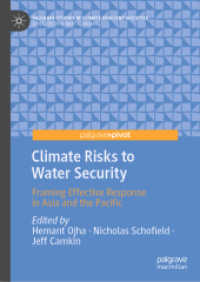- ホーム
- > 洋書
- > 英文書
- > Politics / International Relations
Full Description
In summer 2014, US agencies responsible for the border with Mexico were overwhelmed by tens of thousands of unaccompanied children arriving from Central America. Unprepared to address this unexpected kind of migrant, the US government deployed troops to carry out a new border mission: the feeding, care, and housing of this wave of children. This event highlights the complex social, economic, and political issues that arise along borders. In American Crossings, nine scholars consider the complicated modern history of borders in the Western Hemisphere, examining borders as geopolitical boundaries, key locations for internal security, spaces for international trade, and areas where national and community identities are defined. Among the provocative questions raised are, Why are Peru and Chile inclined to legalize territory disputes through the International Court of Justice, undermining their militaries? Why has economic integration in the "Tri-Border Area" of Argentina, Brazil, and Paraguay increased illicit trade supporting transnational terrorist groups?
And how has a weak Ecuadorian presence at the Ecuador-Colombia border encouraged Colombian guerrillas to enforce the international borderline?
Contents
Acknowledgments
Chapter 1. Borders in the Americas: Theories and Realities
Part I: Geopolitics of Borders
Chapter 2. Borders, Rivalries, and the Racketeer State: An Alternative Theory to State Development in Latin America
Chapter 3. Legalizing and Judicializing Territorial and Maritime Border Disputes in Latin America: Causes and Unintended Consequences
Chapter 4. Political Learning Through a Transgovernmental Network: Resolving the Argentine-Chilean Border Dispute During the 1990s
Part II: National Policies for Border Security and Cross-Border Trade
Chapter 5. Regional Peace and Unintended Consequences: The Peculiar
Case of the Tri-Border Area of Argentina, Brazil, and Paraguay
Chapter 6. Rivalry, Trade, and Restraint on the Colombia-Venezuela Border
Chapter 7. Northbound "Threats" at the United States-Mexico Border: What Is Crossing Today, and Why?
Part III: Licit and Illicit Behavior by Borderland Actors
Chapter 8. Illicit Americas: Historical Dynamics of Smuggling in the United States' Relations with Its Neighbors
Chapter 9. The Colombian FARC in Northern Ecuador: Borderline and Borderland Dynamics
Chapter 10. Making Sense of Borders: Global Circulations and the Rule of Law at the Iguazú Triangle
Chapter 11. Conclusions
List of Contributors
Index







